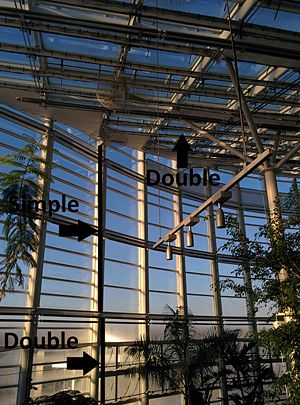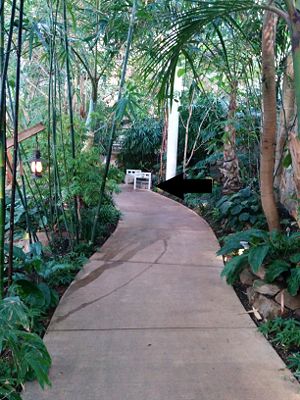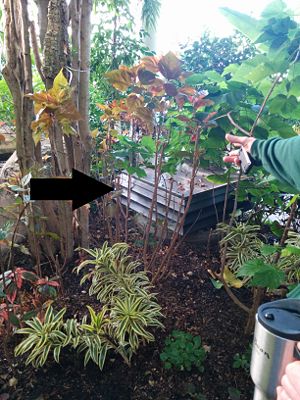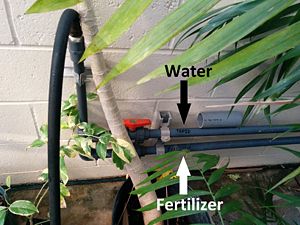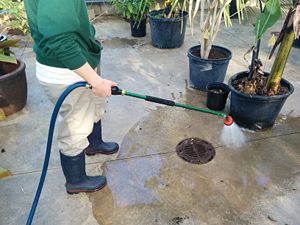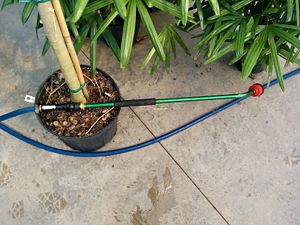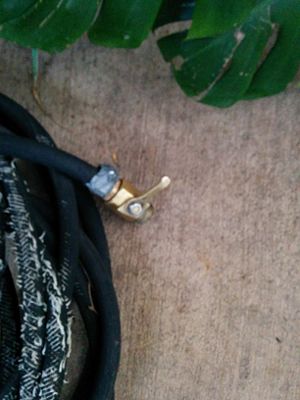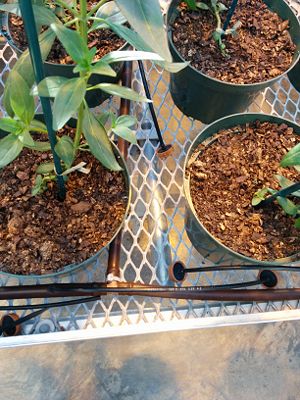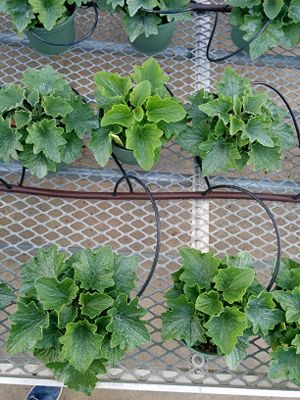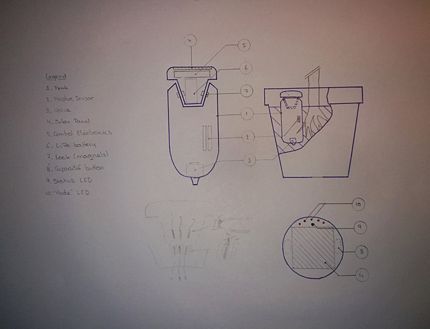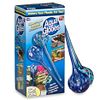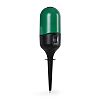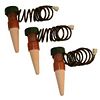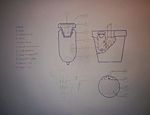Impulse sprinkler opportunity
From DDL Wiki
(→Pugh Chart) |
(→Citations) |
||
| Line 276: | Line 276: | ||
| - | + | =Citations= | |
[1] [http://www.homedepot.com/p/Melnor-Pulsator-Sprinklers-with-Zinc-2-Way-Spikes-2-Pack-308-593/202051545?N=5yc1vZc63c Home Depot Customer Reviews] | [1] [http://www.homedepot.com/p/Melnor-Pulsator-Sprinklers-with-Zinc-2-Way-Spikes-2-Pack-308-593/202051545?N=5yc1vZc63c Home Depot Customer Reviews] | ||
Revision as of 20:20, 21 February 2014
Contents |
Executive summary
Market Study
Add Executive summary for market research here
Expert Interview
Phipp's Conservatory
(DRAFT)
- In a greenhouse, you don’t want to obstruct the sunlight+each plant has different needs -> no sprinkler at the top
- Need “rain” to wash up leaves from dust and insects (the one that plant their mouth inside the vascular tissues ->kill them because it “cut” them since their mouth stays in the leaves and you don’t need too much pesticides
- Sprinklers to prevent cold damage from freezing (5-6 times a year)->cf. apricots and oranges
- Most watering is done by hand
- Automatic watering if all the same plants ->rare, only one room (and rather small) at Phipp’s
- Automatic watering is not aesthetic, and if it fails you can lose precious plants
- When one plant in a whole bunch need a different watering->in a pot
- Air movement is REALLY important (4 reasons):
- plants need some movement -> triggers the plant to have ligments and small internal links -> more resistant
Ex: caoutchouc tree with leaves so heavy that they bend by themselves and break in the middle Short internodes: prettier and stronger plant
- From heating prospective: increases heating efficiency
- More air around the plant to bring the CO2 to the leaves (plants tend (they grow like that) to keep the air inside the leaves -> bushes against wind). Up to 500ppm of CO2 lower if air still -->better plant growth
- To reduce the amount of fungus diseases (stagnant air)
Ex: poinsettias are from the desert of mexico, and in the humid environment they get fungus (white) which spreads really really quickly It’s all about reducing the amount of chemical pesticides, and if you have to replace a full room of poinsettas it’s really expensive (4000$) Ex: fans in the orchid room = 6000$ a year, with 3000$ in the summer that you can’t take of in any casem the 3000$ remaining -> is it worth to lose a whole crop? (cf. poinsettias)
- Heating is conventional steam heating on the walls of the room, behind the wall so that visitors don’t see it. (there is a whole pathway going around the external walls)
- Have to open the vents to renew the air EVEN IN WINTER to cool down the greenhouse, because the .radiators have thermal inertia. ->Computer control system (“ARGUS”) tries to optimize heating to save energy
- No double glass in a greenhouse (so more heat loss), because the exact wavelength plants use is reduced by 20% at each layer of glass->so only one layer of glass
- Fountains, water and others are mainly decorative
- On fridays, everybody waters more because on the weekend there is only a reduced team.
- Insects come from both Pittsburgh and with the plants -> sometime they even find frogs from Florida, those are the one you can hear in one of the rooms of Phipps. they also have birds living there during the winter->doesn’t seem to be a problem, seem even to help by eating the insects and so reducing the amount of pesticides needed.
- Indian forest (warmest room in winter/coolest in the summer): the key is the orientation of the glass:
- Lower (for winter)->simple layer
- Roof (for summer)->double layer
- Bottom: double layer because even in winter the sun is never this low
- Winter: fans shoot the hot air down (heating pipes are on the glass ceiling)
- Summer: fans shutted down->passive cooling: in summer, fresh air is brought from somewhere shady outside and injected in the greenhouse (up to about 5° cooler in the greenhouse than the outside with this system)
Anthropological study
Phipp's Conservatory
(was explaining what they were doing, what was their experience with the product and their feelings about it, and at the same time were doing it)
- Fertilize by switching the source at the connection of the hose -> you lose a lot of water each time
- Hold the HOSE and the bar to operate the jet
- Unscrew the tube (diffuser) to wash leaves and have a stronger water-shoot.
Ask if inconvenient? -> No
- You have to screw and unscrew the hose, the nozzles, everything all the time-> clipping would probably be way more convenient
User interviews
Phipp's Conservatory
Users reports that the most annoying thing is that sometimes it leaks and there is nothing you can do about it on the go.
Orchids and some tropical plants don’t like city water (because of the salts) -> inverse-osmosis (from water they recapture from the greenhouse) But really inconvenient->bringing this water all the way from the orchis house in a big container… And they don’t have too much of that water
Other user: Main complaints about the individuals watering systems and that you cannot monitor how much water have the roots->sometimes it’s completely wet outside but there is no water for the roots…
Watering pots, not convenient:
- long to set up
- when you have different plants on the same table/feeder and they need different watering…
Idea: monitor exactly how much water you have in the roots
Solutions we proposed: water by the table?->moses and algae (big concern the algae), you have to wash it->but they will try two of them soon with water already used They used capillary mats on which the plants are put
User reviews
For the sprinkler that we dissected for the first report, the most valuable consumer feedback was available through Home Depot's online customer reviews [1]. The average grade from 43 sprinkler set reviews was 2.3/5. From going through the comments and keeping a tally of reported issues, a few major design flaws with the system became apparent. The most common issue, surprisingly, was the supporting stake bending or breaking. Three users reported that the stake broke altogether and another eight complained that it bent when attempting to put it in the ground. This was somewhat surprising because it is made of zinc and seemed to be one of the more sturdy parts of the system. The next most common issue, reported by 9 of 43 people who reviewed it, was that the sprinkler would often become stuck instead of rotating. This seemed to be mostly due to the design issue with clip height that was noted in the FMEA analysis in the first report. There were also many other issues. Three people said that the sprinkler simply fell apart, and there were seven total reviews with issues stemming from inadequate coverage, including uneven and small coverage areas. Other reviews mentioned leaking, clogging, difficulty with adjusting the settings and making them stay, cracking of the plastic, leaning to the side on wet ground, and spinning off the spike. In addition, five reviews stated simply that the sprinkler stopped working without going into further detail. The fact that all of these issues came up in just 43 customer reviews shows that there is a lot of room for improvement with this product.
Design concepts (top 5)
(Syllabus:Provide sketches and descriptions of your top 3-5 design concepts, describing what opportunities have been identified and how they will be addressed.)
Water can redesign
Slap-Chop dirt loosener
Automatic underground water dispenser
One issue that was pointed out by both professionals (Phipp's Conservatory) and "hobbyist" (flowers store and many others questioned people) is that plants in pot die as often from a lack of watering than from an over watering. And when you water from the top, it can be totally wet but the roots are, in fact, completely dry... One of the Phipp's employee said that it would be great to have for instance something that you put in the ground and by itself decides whether or not it has to give water, how much, and that would be done directly into the roofs. The flowers shop owner told us that the aqua globe are great so that people don't forget to water, or over water their plants, but it maintain a constant level of humidity in the soil, and the plant need a cycle dry-humid (depending on the time of the day, the season, the temperature, the lighting...) We addressed this need with an automatic (underground) water dispenser. Powered by small solar panels and a small Lithium-Ions rechargeable battery, with a very simple interface (say on a scale from 1 to 5 how much water this type of plant needs) and sensors (moisture sensor at least, but we could add sensors for temperature external/internal, light, external humidity...) a small micro-controller (probably based on an Arduino for the prototype) would act on a valve to dispense water when the plant needs it, and where the plant needs it, i.e. the roots, and with the appropriate cycle.
Our design consists of a tank of water, in the soil of the pot ("underground") or even built-in the pot (for obvious aesthetic purposes, even if it would be possible to make for instance a really design glass water tank), on which the stopper would consist of the assembly solar panel- control electronics (c.f. drawings for more details)
The design is such that you only need to buy one cap (the most expensive part), and you can buy tanks of different volumes for low price (less that 5$). By such providing, at relatively low cost, a wide variation of colors, functions, and water tank sizes, the product could be diversified to satisfy each client.
The main challenges in the conception of the realization design would be to have:
- A convenient an efficient way to connect electrically the stopper to the tank, since the stopper has to be removed to fill the tank and holds the electronic. It also has to be put on and off easily (For instance with a magnetic lock)
- Low power valve
- How to embed the different electrical components and cable into the tank to reduce costs
- Create a simple user interface water-resistant
Relevant competitor products and Patents
- Aquaglobes: A bulb full of water keep the moisture level constant in the soil by letting water go out when the soil is dry
- Inovalley AA02 Automatic Water Dispenser for Plants
- Ceramic Watering Probes
- Most relevant Patent: Self-contained automatic plant watering apparatus system and method for operating same US 20130205662 A1
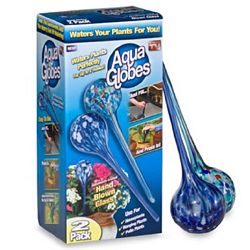 Aquaglobes (Source:Amazon.com website) |
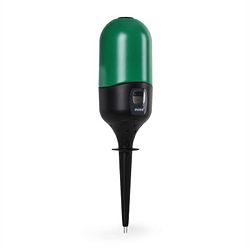 Inovalley AA02 Automatic Water Dispenser for Plants (source: hifi-tower.co.uk) |
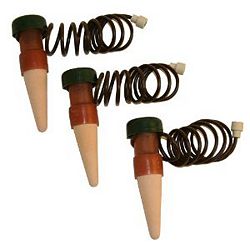 Ceramic Watering Probes 6001-TC (Source:Amazon.com website) |
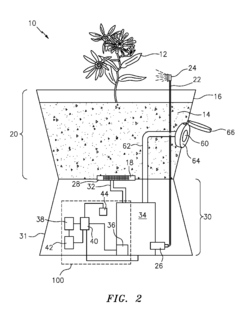 Self-contained automatic plant watering apparatus system, (Source: US Patent 20130205662 A1) |
Pugh Chart
The Pugh Chart compares our design to the existing concurrent products presented before, with as Datum the Aqua Globe.
| Description | Standard: Aquaglobe | Inovalley AA02 Automatic Water Dispenser | Ceramic Watering Probes | Automatic underground water dispenser | |
|---|---|---|---|---|---|
| Sketch | |||||
| Criteria | weight | Datum | Competitor 1 | Competitor 2 | Design |
| Durability | 1 | 0 | + | - | + |
| Aesthetics | 3 | 0 | 0 | - | ++ |
| Time between refills | 2 | 0 | 0 | ++ | + |
| Affordability | 2 | 0 (8$ p.) | -- (48$ p.) | 0 (7$ p.) | -- (~20$ p.) |
| "Quality" of watering (cycles...) | 2 | 0 | ++ | 0 | ++ |
| Complexity (manufacturing) | 1 | 0 | -- | - | -- |
| Ease of integration | 1 | 0 | 0 | 0 | - |
| Easy to use | 2 | 0 | + | 0 | + |
| + | 0 | 7 | 4 | 15 | |
| 0 | 7 | 3 | 2 | 0 | |
| - | 0 | 7 | 5 | 7 | |
| Net score | 0 | 0 | -1 | 8 | |
Relevant competitor products
(Syllabus: Identify relevant competitor products from your patent searches, commercial searches, web searches, and expert interviews. Compare pros and cons of each of your concepts on a standard Pugh chart against your top stakeholder needs, and benchmark against the most relevant competitors. If your concepts are better on some attributes and worse on others, identify any market segments likely to value the tradeoffs you can offer.)
Gantt Chart
(Syllabus:Provide a Gantt chart to map out the team plan for design and prototyping through the remainder of the semester. Please be detailed to your particular project and individual member contributions.)
Team member roles
Finding and Recommandations
(Syllabus:Summarize your findings and recommendations. In particular, identify which concept you recommend pursuing for the remainder of the semester. Provide a hypothetical before & after user scenario representative of your target market from your research findings to motivate your top solution concept)
List of at least 100 brainstorming ideas
